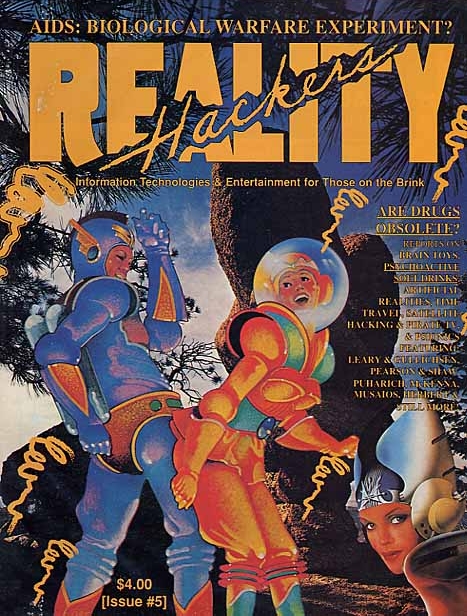
“The oddest thing I did was attend an underwater cabinet meeting in the Maldives.”
Mark Stevenson’s An Optimist’s Tour of the Future is a rare treat — an upbeat tour visiting major shakers behind all the technologies in transhumanism’s bag of tricks — written by a quippie (a culturally hip person who uses amusing quips to liven up his or her narrative). Stevenson trips through visits to genetic engineers, robotics, nanotechnology enthusiasts, longevity seekers, independent space explorers and more among them names you’ll recognize like Ray Kurzweil, Aubrey de Grey, Eric Drexler and Dick Rutan.
I interviewed him via email.
RU SIRIUS:Â Were you an optimist growing up?
MARK STEVENSON: No, not especially – although I was always trying new things. For most of my childhood I was convinced I was going to be a songwriter for a living.
RU: What made you look forward to the future?
MS: I think that’s a natural thing that humans do. Time is a road. Those who don’t pay attention to the road tend to crash. A better question is: what stops people looking to the future? One reason is because the story we hear about the future is so rubbish. I mean think about it. If I recall the story of the future I’ve been used to hearing since I was born pretty much it goes something like this: “The future is not going to be very good (especially if you vote for that guy), it was better in the old days, you’ve got to look after yourself, the world is violent and unsafe, your job is at risk, your boss is an idiot, your employees are lazy, the generation below you are feral and dangerous, things are changing too fast and you can’t trust those scientists/ new-agers/ left wingers/ right wingers /religious people /atheists /the rich /the poor /what you eat /your neighbor. You are alone. Make the best of it. Vote for me. Buy my paper. I understand.†It’s hardly inspiring, is it?
RU: As you’ve promoted the book, have you run into arguments or questions that challenge optimistic views?  What’s the most important argument or question?
MS: I’m not intrinsically optimistic about the future; I’m not an optimist by disposition. I’d say I’m a possibilist – which is to say, it’s certainly possible that we’ll have a much better future, but it’s also certainly possible that we’ll have a really rubbish one. The thing that’s going to move that in one direction or another will be how all of our interactions in the march of history nudge us. One thing I do know is, if you can’t imagine a better future, you’re certainly not going to make it happen. It’s like going into a job interview thinking about how you’re not going to get it. You just won’t get the job. The biggest problem I have is semantic. As soon as you associate yourself with the word “optimism†some people will instantly dismiss you as a wishful thinker who really hasn’t understood the grand challenges we face. As a result, I constantly have to battle against a lazy characterization of my views that suggest I am some kind of Pollyanna in rose-tinted spectacles. My position is simply this: that we should have an unashamed optimism of ambition about our future, and then couple that with our best creative and critical skills to realize those ambitions. Have good dreams – and then work hard to do something about them. It’s obvious stuff but it seems to me that not nearly enough people are saying it these days.
RU:Â Since writing the book, what has happened that makes you more optimistic?
MS: That there is a huge hunger for pragmatic change – in fact I’m setting up The League for Pragmatic Optimists to help catalyze this. Also I’m being asked to help organizations re-imagine themselves. That’s challenging and hopeful. The corporation is one of the biggest levers we have for positive change.
RU:Â Less optimistic?
MS: When we talk about innovation we easily reference technology, medicine – or we might talk about innovation in music, dance, fashion. But we rarely talk about institutional innovation, and nowhere is this more apparent than in government. Almost every prime minister or president at some point early into their first term of government gives a rousing and highly ironic speech about how they wish to promote innovation. But isn’t it strange that while governments (and many corporations it has to be said) so often talk about stimulating innovation they themselves don’t change the way they work. When we introduced parliamentary democracy in the 1700s it was a massive innovation, a leap forward. Yet here we are, 300 years later and I get to vote once every four years for two people, both of whom I disagree with to run an archaic system that cannot keep up with the pace of change. To quote Einstein,  “We can’t solve problems we’ve got by using the same kind of thinking we used when we created them.†It’s why I now dedicate much of my life helping institutions change the way they think about their place in the world and the way they operate.
RU: Among the technologies you explore, we can include biotech, AI and nanotech. In which of these disciplines do you most see the future already present. In other words, whether it’s in terms of actual worthwhile or productive activities or in terms of stuff that’s far along in the labs, where can you best catch a glimpse of the future?
MS: To quote William Gibson: “The future is here. It’s just not widely distributed yet.†So, synthetic biology is already in use, and has been for a while. If you’re diabetic, it’s almost certain your insulin supply is produced by E. coli bacteria whose genome has been tinkered with. The list of nanotechnology-based consumer products already available numbers thousands including computer memory and microprocessors, numerous cleaning products, antimicrobial bandages, anti-odour socks, toothpaste, air filters, sunscreen, kitchenware, fabric softeners, pregnancy tests, cosmetics, stain resistant clothing and pet furniture, long-wearing paint, bed-ware, guitar strings that stay sounding fresh thanks to a nano-coating and (it seems to me) a disproportionate number of hair straightening devices. It looks set to underpin revolutions in energy production, medicine and sanitation. Already we’re seeing it increase the efficiency of solar cells and heralding cheap water desalinization/purification technology. In fact, the Toffler Institute predicts that this will “solve the growing need for drinkable water, significantly reducing global conflict between water-starved nation-states.†In short, nanotech can take the ‘Water War’ off the table.
When it comes to AI I’m going to quote maverick Robot designer Rodney Brooks (formerly of MIT): “There’s this stupid myth out there that AI has failed, but AI is everywhere around you every second of the day. People just don’t notice it. You’ve got AI systems in cars, tuning the parameters of the fuel injection systems. When you land in an airplane, your gate gets chosen by an AI scheduling system. Every time you play a video game, you’re playing against an AI systemâ€
What I think is more important to pay attention to is how all these disciplines are blurring together sometimes creating hyper-exponential growth. If you look at progress in genome sequencing for example — itself an interplay of infotech, nanotech and biotech — it’s outstripping Moore’s Law by a factor of four.
RU: What would you say was the oddest or most “science fictional†scene you visited or conversation you had during the course of your “tour�
MS: The most “science fictional†was meeting the sociable robots at MITs Personal Robotics Group. Get onto You Tube and search for “Leo Robot†or “Nexi Robot†and you’ll see what I mean. Talking of robots, check out video of Boston Dynamics “Big Dogâ€Â too.
The oddest thing I did was attend an underwater cabinet meeting in the Maldives – the idea of the first elected president of the nation, Mohamed Nasheed. (I was one of only one of four people not in the government or the support team allowed in the water). As we swam back to the shore I found myself swimming next to the president. His head turned my way and I must have looked startled because he made the underwater hand signal for “Are you okay?†I signalled back to assure him I was because there is no hand signal for “Bloody hell! I’m at an underwater cabinet meeting in the Maldives! How cool is that?!â€
RU: Many of our readers are transhumanists. What course of action would you recommend toward creating a desirable future.
MS: During my journey I spoke to a man called Mark Bedau, a philosopher and ethicist who said: “Change will happen and we can either try to influence it in a constructive way, or we can try to stop it from happening, or we can ignore it. Trying to stop it from happening is, I think, futile. Ignoring it seems irresponsible.â€
This then, I believe, is everybody’s job: to try an influence change in a constructive way. The first way you do that is get rid of your own cynicism. Cynicism is like smoking. It may look cool but its really bad for you — and worse still its really bad for everyone around you. Cynicism is an institution of the mind that’s just as damaging as anything our governments or our employers can do to us.
I also like something a man called Dick Rutan told me when I visited the Mojave Space Port. He’s arguably the world’s finest aviator, most famous for flying around the world nonstop on one tank of gas. He’s seventy years old and still test piloting high-performance aircraft, and he told me: “Never look at a limitation as something you ever comply with. Never. Only look at it as an opportunity for greatness.â€
RU: Your book is pretty funny… and you’ve been a stand up comedian. What’s the funniest thing about the future?
MS: My next book, obviously!


